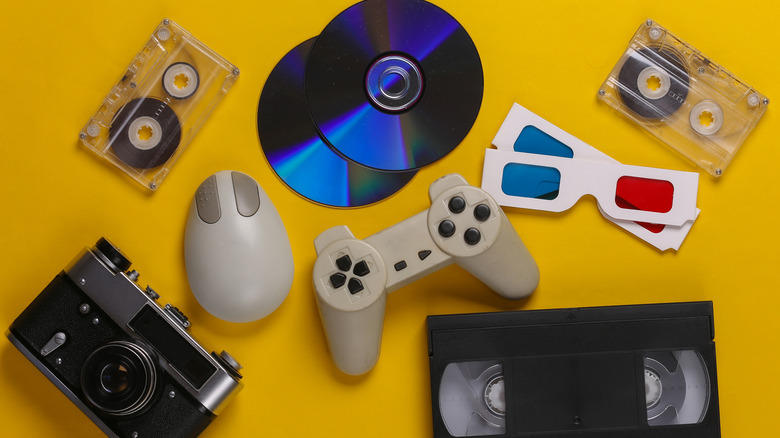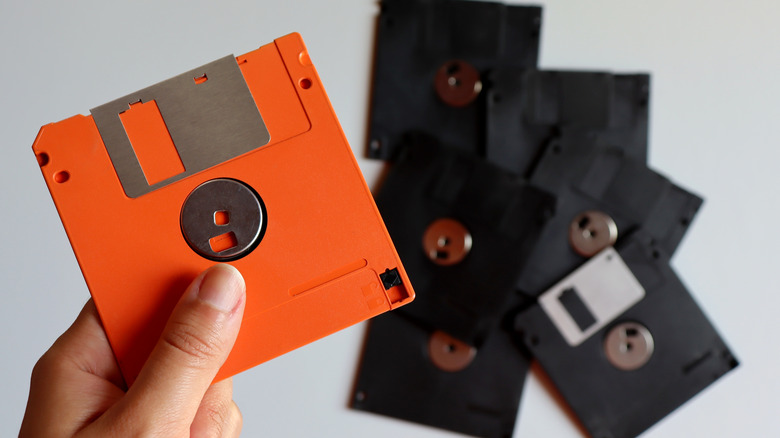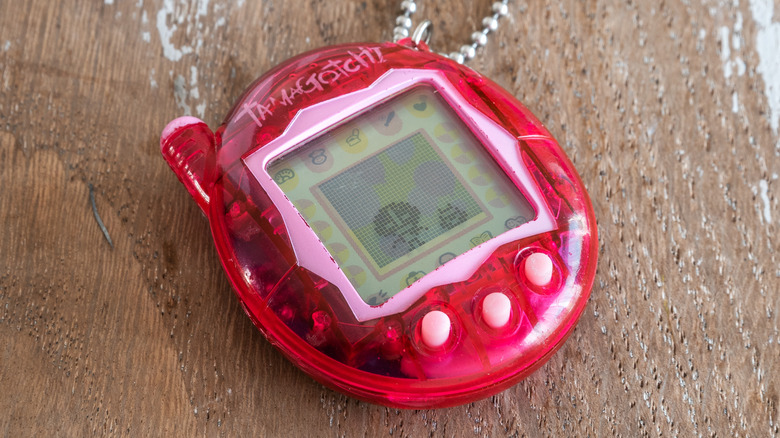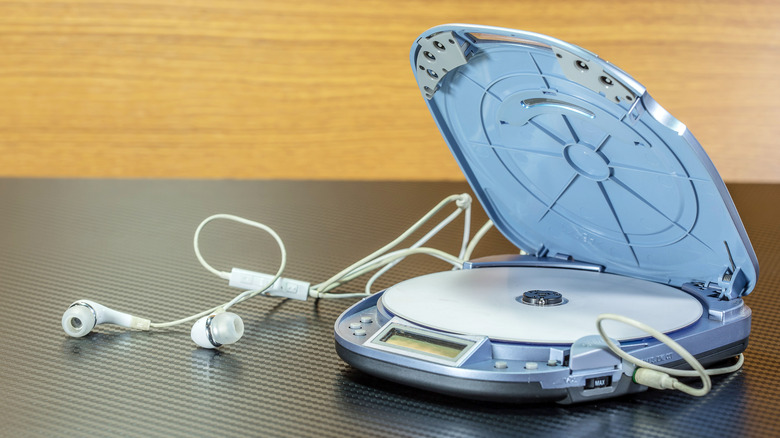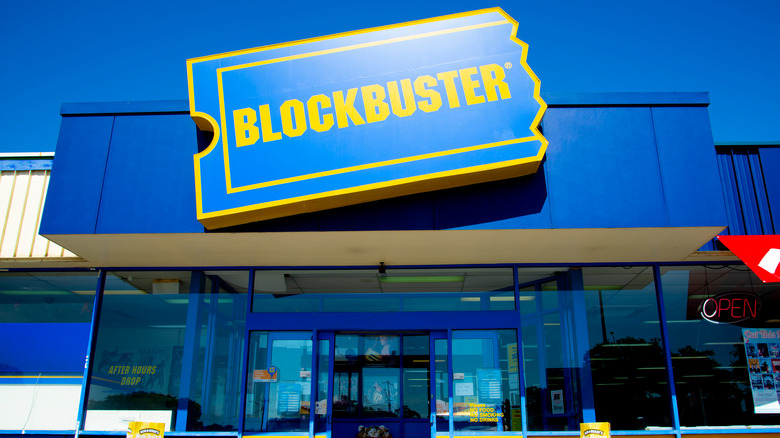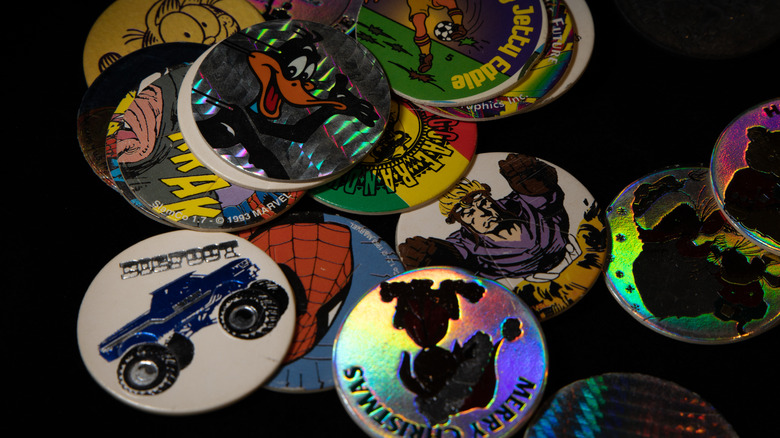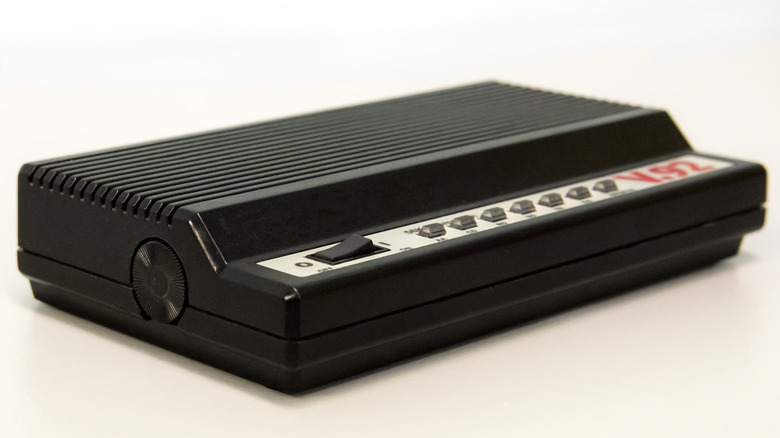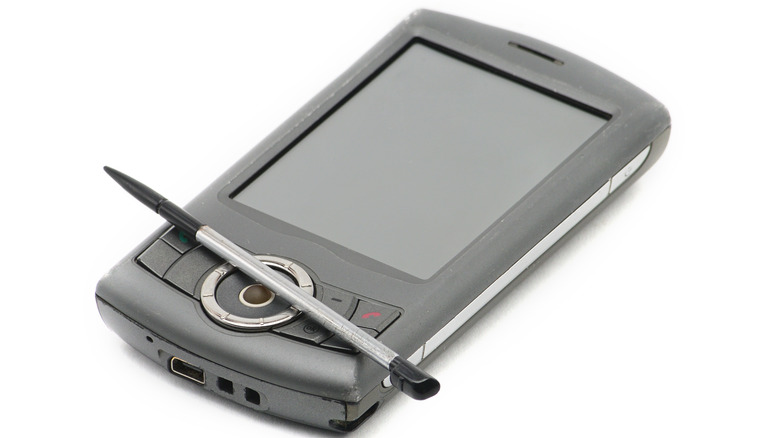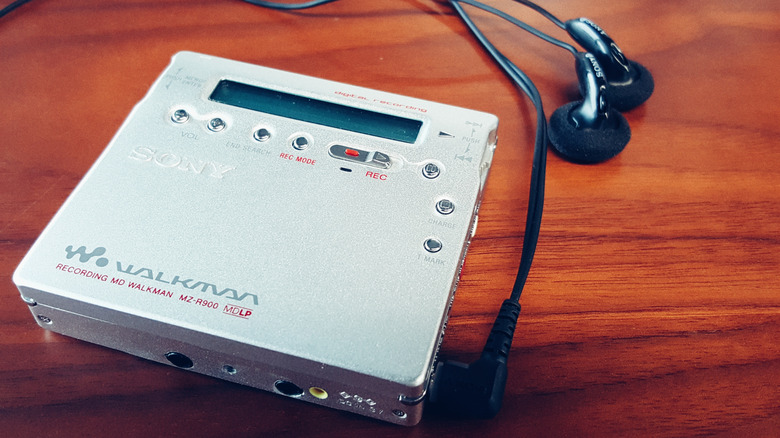Popular Things From The 1990s You Don't See Anymore
One can argue that the 1990s shaped the world of today like no other decade did. It was the decade when Sir Tim Berners-Lee, inventor of the World Wide Web, created the first Web browser, completely transforming the landscape of information exchange (via Time). It was also the decade when engineer Neil Papworth sent the first SMS message — a simple Christmas greeting to Vodafone director Richard Jarvis — kicking off another major disruption in global communications (via ZDNet). In many ways, the era of digital cable television, "Friends," and the Spice Girls left an indelible mark on society.
That said, there were quite a few things that enjoyed massive popularity in the 1990s, but gradually (or in some cases, quickly) faded into obscurity or even obsolescence almost as soon as the 21st century began. Some of these trends and technologies managed to live on in other forms, but never managed to reclaim the spotlight. Others simply could not keep up with the changing times, going the way of the dinosaurs as newer, better alternatives popped up. Take a look at some popular things from the 1990s that you don't see anymore.
Floppy disks
People still see the floppy disk these days, albeit in a different form. As tech magnate Bill Gross joked on Twitter, younger generations would likely recognize it as the "Save" icon, and nothing more. Longtime techies, however, are certainly familiar with this computing milestone (and why it became a literal and figurative icon).
According to How Stuff Works, the first 8-inch floppy disks and drives emerged in 1967. By 1981, they had shrank to 5.25 inches and could store up to 360 kilobytes of data. The "floppy" part comes from the fact that the storage disks initially came in a "very flexible plastic envelope." Over time, the technology evolved even further, becoming smaller, sturdier, and capable of holding more data. Throughout the 1990s, it was common to see people saving their files to 3.5-inch floppy disks (or "diskettes"), which had a storage limit of 1.44 megabytes.
However, the increasing popularity of CDs and portable storage devices in the late '90s and early 2000s spelled the slow but steady doom of the diskette (via PC World). Forrester Research analyst Andrew Reichman told The Telegraph in 2007, "The floppy has not been able to keep up ... There is not enough room on a floppy for one song or one photograph from a high-resolution camera." That said, the floppy disk hasn't gone completely extinct yet; nuclear weapons systems, airplanes, and computer hobbyists still use them, either due to reliability, convenience, or plain nostalgia (via How-To Geek).
Tamagotchi
In the late 1990s, Japanese toymakers Akihiro Yokoi and Aki Maita came up with the perfect solution to a common problem: What if you were a kid who wasn't allowed to take a pet on trips — or worse, a kid who wasn't allowed to own a pet in the first place?
Enter the Tamagotchi, a pocket-sized, egg-shaped, three-button technological marvel that was half pet and half electronic game. With its simple system and controls, Tamagotchi owners could choose from an assortment of virtual pets to watch, feed, and play with. And much like a real pet, Tamagotchi pets could die if their owners didn't take good care of them, serving as a stern lesson in responsibility while eliminating the tragedy of having a living, breathing creature perish in the care (or lack thereof) of a negligent owner.
The Tamagotchi became a smash hit, selling 82 million units across the world from 1996 to 2017 and sparking a global craze. Both children and adults kept their own pocket pets, obsessing over them to the point of neglecting their own real-world responsibilities. But eventually, the Tamagotchi's star faded, as newer distractions stole the spotlight. There have been attempts to revive the brand in the 2000s (via CNN). However, none have succeeded in lifting the tiny egg high enough to reach its former levels of fame.
Cassette tape recorders and players
In the "Guardians of the Galaxy" films, the intergalactic hero Star-Lord carries with him an iconic piece of Earth technology: a portable cassette player, serving as the only physical reminder he has of his previous life. Pop culture references such as this have kept cassette tape recorders and players alive in the public consciousness. Still, these devices are nowhere near as popular or ubiquitous as they used to be.
Compact cassette tapes were introduced to the world in the early 1960s, born out of a desire to create smaller, more cost-efficient alternatives to larger reel-to-reel tapes (via NPR). Nearly two decades later, electronics manufacturer Sony released what would become a music industry milestone: the Walkman, the company's line of portable cassette tape players. According to a 2014 article from The Verge, the music player didn't generate much revenue in its first month. Sales eventually picked up steam, however, particularly in the '90s. As of the early 2010s, the company had reportedly sold 200 million Walkman cassette players worldwide. The decline of the cassette player's popularity resulted from the emergence of CD players as an attractive new audio format (via CNN).
Interestingly, nostalgia has saved cassette tapes from the jaws of extinction. As Gear Patrol notes, its appearances in films and TV shows, as well as a number of musicians opting to release their albums in the format, have helped fuel a quiet revival of sorts in recent years.
Compact disc players
Many major tech trends of the '90s had to do with entertainment — specifically, how to make it more convenient for consumers to keep themselves occupied wherever they are, without sacrificing quality. This was what helped compact discs (CDs) find a strong footing with the commercial audience during the decade. Interestingly, it was also what led to the CD's downfall as the medium of choice for audiophiles.
According to BBC News, Europe and Japan were the first regions to know about the CD in 1979, during its early stages of development. Subsequent innovations in the medium sprang forth from the efforts of two electronics manufacturers, Philips and Sony, with the CD finally seeing widespread commercial release three years later. The flat, circular disc could hold 80 minutes' worth of tracks, and was easier to store and keep safe than clunky cassette tapes or bigger, more fragile vinyl records. Sony released the Discman in 1984, but rebranded it to the "CD-Walkman" 15 years later (via The Verge). Near the end of the '90s, the company had already sold about 50 million CD players, overshadowing initial alarmist concerns about the products potentially causing hearing problems and even street accidents.
However, the launch of iTunes in 2001 became a major blow to the CD's popularity, as it gave listeners access to a much wider library of songs without the storage limitations of a physical disc. Since 2008, CD sales have reportedly dropped by 10 million annually.
VHS tapes
VHS (Video Home System) tapes were a huge hit in the 1990s. The home video market alone reportedly generated 50% of all studio revenue during the decade, according to MentalFloss. The road towards its dominance in the home entertainment industry wasn't easy, though.
As far back as the 1950s, audiences had already been looking for a way to be able to catch their favorite television shows without staying glued to their screens all day. To fill this need, videocassette recorders (VCRs) were introduced to consumers, and two incompatible formats by rival manufacturers dominated the market: the Betamax by Sony and the VHS by JVC. The VHS won this so-called format war, edging out its technically superior competitor simply because it was cheaper and had a recording capacity that was two to four times as long (via National Interest). Videomaker reports that by the 1980s, VHS had already taken hold of 60% of the North American market and it peaked in popularity during the following decade.
However, the decline of the VHS format began in 1996, when manufacturers introduced the DVD (Digital Video Disc) format. DVDs were easier to store, and boasted better quality than cassette tapes. American consumers adopted the new format quickly, with DVD player sales reaching 50 million in half the time it took for the VCR to achieve the same (via Washington Times). The 2006 release of "A History of Violence" on VHS marked the last time a major Hollywood film would be released in the once-popular format, according to the LA Times.
Pagers (beepers)
When engineer Al Gross invented the telephone pager (or beeper) in 1949, it took a year before health professionals — the people he designed it for — started using it in their daily practice (via Lemelsom-MIT). Many of them thought that the alerts would be bothersome for their patients, and that using the devices would open the floodgates to disruptions in their leisure activities. The device turned out to be so useful, though, that the majority of remaining pager users in the post-smartphone era are from the medical profession.
According to Slate, about 61 million beepers were in active use worldwide in 1994. The tiny communications device became an icon of the era, with even non-doctors using them. Interestingly, as they became the "preferred tool of drug dealers," many schools banned them (via The New York Times). With the introduction of mobile phones, however, the pager experienced a speedy downfall; techies were drawn to the functionality and versatility of cellular phones, favoring them over the annoying beeps and limited capabilities of a pager.
The pager hasn't completely disappeared yet, though. A 2016 article in The Boston Globe states that pagers were still in use in about 85% of hospitals. In 2017, The Guardian attributed the continued existence of this technology to the fact that it has "slightly more reliability" than phone networks, as well as a longer battery life than today's smartphones.
Blockbuster stores
Blockbuster first opened its doors in 1985, and it didn't take long before it dominated the global movie rental industry (via Business Insider). Within seven years, it grew to 2,800 outlets and expanded to the United Kingdom. At its peak in 2004, Blockbuster reportedly had 9,000 stores operating across the world. However, frustrations with the rental giant's late-fee policies led to a disgruntled customer eventually establishing the David that helped bring down the home video Goliath.
According to Quartz, nearly a fifth of Blockbuster's revenue came from the per-diem fee that it charged for late movie returns. While most consumers continued to patronize the business, Reed Hastings felt like challenging the system. Thus, he founded Netflix in 1997 as a DVD sales and rental service that only charged a flat rate per month, with no late fees (via Business Insider). In 2002, another competitor emerged in the form of Redbox, which, like Netflix, did not charge late fees.
Over time, the once-formidable chain saw a steady decline, losing three-quarters of its market value from 2003 to 2005 (via Forbes). Further contributing to Blockbuster's fall was its decision not to purchase Netflix when it had the option to, back in 2000. The company filed for bankruptcy in 2010, and in succeeding years, nearly all of its stores closed down. The last Blockbuster standing is in Bend, Oregon, which has become something of an attraction after being featured, rather ironically, in a Netflix movie (via U.S. News & World Report).
Pogs
In 1991, an educator in Hawaii named Blossom Galbiso taught her students a new playtime activity: a game of milk cap flipping that her grandparents played more than half a century earlier (via First We Feast). In place of milk caps, Galbiso used disposable lids of a local fruit beverage line called Passion Orange Guava (POG). Unexpectedly, the game became a massive hit across the United States — though a combination of factors during the following decade cut its time in the spotlight short.
Within three years, nationwide sales of Pogs reached a staggering 350 million units, with California reportedly selling $10 million worth on a weekly basis. The game became so popular that even the Catholic Church hopped on the bandwagon. The New York Times reports that Pope John Paul II commissioned 50,000 Pogs featuring the holy leader's face, which he handed to children during his 1995 visit to New Jersey.
Like other '90s fads, though, the Pog craze died down because of negative associations and market saturation. According to The Baltimore Sun, schools started banning Pogs to curb gambling among students; it also didn't help that so many brands capitalized on the trend, resulting in a deluge of products. Ironically, the manufacturers of the POG drink, Haleakala Dairy, missed out on profiting from Pogs, to the point where they filed multiple lawsuits to stop any other company from calling their products Pogs. An attempt to revive the game was launched in 2005, but ultimately failed.
Dial-up internet
For people who grew up in the mid-1990s, that series of beeps, clicks, and static noises is unmistakable: For the next couple of hours or so, they'd be praying that no one would try to contact them via phone, as they'd be too busy surfing the internet at an astonishing 56 kb per second. Which, as Quartz pointed out, meant that it would take three and a half days to download a file that only takes half a minute with today's broadband connections.
Dial-up internet modems require a phone line to connect to the World Wide Web, rendering the user's phone line unusable. Up until the early 2000s, this was the norm for anyone who wanted to browse their favorite Web pages.
Initially, many loyal dial-up users refused to switch to broadband connections due to infrastructure gaps and higher price tags (compared to dial-up connections). Since its inception, though, the cost of broadband internet has dropped to more affordable levels. This, plus the fact that broadband internet doesn't need a phone line to work, has convinced an increasing number of United States users to make the switch. By 2008, the number of adults in the United States who were still on dial-up went down to just 10%, according to a study by the Pew Research Center. Follow-up research in 2013 revealed that the number had dwindled further, to just 3%.
PDAs
When Apple CEO John Sculley coined the term PDA (personal digital assistant), it was to describe the company's 1993 product, the Newton MessagePad. Considered a "revolutionary product" for its time, the Newton featured character and limited handwriting recognition for data input, plus minimal infrared support. Despite selling 80,000 Newton units in the year it was launched, Apple ceased producing new models by 1998, due to their inability to lower the cost.
That didn't stop the PDA from exploding in popularity, though — and it was largely because of Palm's 1997 version (via PC Magazine). When the company released the PalmPilot, it sported a user-friendly interface, a longer battery life, and a more efficient data input system compared to its peers. The PalmPilot's success, along with similar products such as Hewlett-Packard's Jornada line and Compaq's iPAQ Pocket PCs, helped the PDA market thrive for years, with users enjoying the devices' data input, media playing, and calculating capabilities, among other features.
With the introduction of smartphones, however, the PDA's popularity began to wane (via NBC News). By the mid-2000s, many major vendors unsurprisingly abandoned the PDA market, as mobile phones incorporated more features than PDAs at a comparable cost. Palm even released the Palm Phone in 2018, which PC Magazine described as "just a secondary phone that gives you just enough connectivity that you can leave your main phone at home."
MiniDisc player
While Sony's MiniDisc player wasn't exactly what you would call a smash hit — it sold "only" 50,000 units during the year of its launch, according to The Guardian — the portable music device became popular because of the company's efforts to market it. Sadly, it turned out to be a case study demonstrating how a combination of ill timing and being out of touch with consumers can spell doom for a product, regardless of what it offers.
As The Verge recounts, the electronics company released the MiniDisc player in 1992 as a powerful, mobile alternative to both cassette tapes and CDs. However, the high cost of the product ($750) made it unattainable for Sony's teenaged target audience. That didn't stop the company from trying to make 1998 the "Year of the MiniDisc," complete with a $30-million marketing push. The company even reduced the price of later models to a third of the price of the original MZ-1. Unfortunately, the iPod arrived on the scene three years later, changing the music landscape and leaving the MiniDisc in the dust. Sony stopped producing MiniDisc devices in 2013, though How-To Geek reports that the company still manufactures blank MiniDiscs exclusively for the Japanese market.
CRT computer monitors
Computers in the 1990s and the mid-2000s utilized cathode ray tube (CRT) technology for their monitors — the same technology embraced by television sets dating back to the 1950s (via How-To Geek). According to MIT News, CRT computer monitors were at the height of their popularity in 2000, selling 90 million units all over the world.
However, with the increasing availability of LCDs and other flat-screen displays, CRTs have been steadily phased out of production. Aside from being more expensive to manufacture, CRTs consume more power, produce more heat, and are bulkier and more obtrusive than flat screens. Moreover, flat-screen displays trump CRTs in terms of overall picture quality and resolution. On the other hand, CRT monitors can still beat earlier LCD models in terms of response time, multi-sync resolution support, and color richness. While the majority of United States manufacturers have ceased CRT monitor production, demand still exists for these retro-inspired systems, mostly from nostalgic computer enthusiasts.
